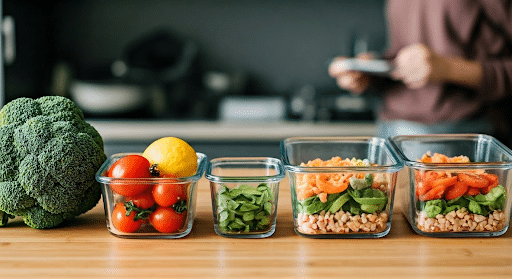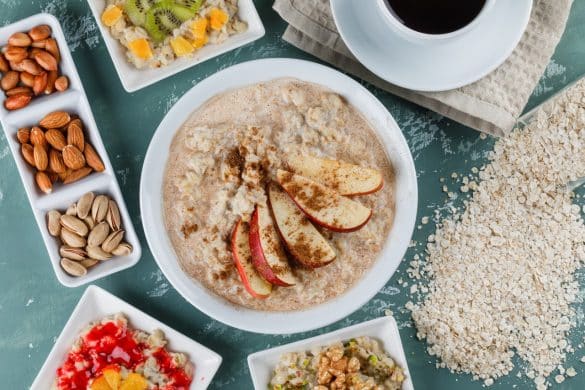Welcome to your guide on healthy eating habits and the pathway to personal wellness. In today’s fast-paced world, we often forget the integral role that our diet holds in the overall health benefits of our body. By adopting healthy eating habits, not only can we maintain an adequate weight, but we can also keep our body functioning at its best. Achieving such a beneficial lifestyle doesn’t necessarily mean completely overhauling your diet; in fact, small, consistent changes can go a long way.
This guide offers simple and feasible methods to improve your everyday eating habits, providing a holistic approach towards achieving an overall state of wellness—a mindful transformation journey that begins with your plate. So read on to savour a journey of healthy eating that promises a wholesome transformation in how you consume your meals.
What is the Importance of Healthy Eating Habits for Overall Wellness?
Good eating habits are pivotal for maintaining overall wellness. Consuming a variety of nutrient-rich foods fuels our bodies, promoting optimal cell growth and repair. Also, maintaining a balanced diet helps prevent chronic diseases such as heart disease, obesity, blood pressure, and diabetes. It supports the healthy functioning of various body systems, manages body weight and keeps our energy levels high. Ultimately, by inculcating healthy eating habits, we contribute towards building a robust immune function, maintaining a healthy gut, preserving cognitive health, and promoting longevity.
How to Develop Healthy Eating Habits?
Cultivating healthy eating habits is a journey, not a destination. It’s about making sustainable choices that nourish your body and fuel your lifestyle. By incorporating simple changes into your daily routine, you can reap the benefits of a balanced diet and improve your overall well-being. Let’s delve into some practical tips to help you embark on this journey towards a healthier you.
Acknowledge the Importance of Building a Balanced Diet

Balanced diet
A balanced diet is a cornerstone of a healthy lifestyle. It involves consuming a variety of nutritious foods in the right proportions to meet your body’s needs. This includes a mix of carbohydrates (like whole grains), proteins (from animal or plant sources), fats (primarily unsaturated fats), vitamins and minerals. Equally essential is the inclusion of plenty of fibre-rich fruits and vegetables, along with sufficient hydration from water and other non-sugary beverages.
Building a balanced diet can improve your overall health, boost your energy levels, and reduce your risk of chronic diseases. Let’s explore the essential components of a balanced diet and practical tips to incorporate them into your daily life.
Food Groups and Their Benefits
Different food groups play unique roles in supporting our health; therefore, a balanced diet incorporates a mix of these groups. Here is a summary of these food groups and their nutritional benefits:
- Whole grains: Rich in fibre, they aid digestion and provide sustained energy.
- Proteins: Found in Meat, eggs, dairy, and legumes, they are crucial for body repair and building muscle.
- Fruits and Vegetables: Loaded with vitamins, minerals, and antioxidants, they support immune function and disease prevention.
- Dairy: Primarily a source of calcium and vitamin D, crucial for bone health.
- Fats: Specifically, unsaturated fats found in nuts, seeds, fish and olive oil support cognitive function, absorption of fat-soluble vitamins, and energy.
Portion Sizes and Serving Suggestions
Controlling portion sizes is a significant aspect of a balanced diet. It ensures that you get all the nutrients you need without overeating. Following are the suggested serving sizes for a few common food groups:
| Food Group | Suggested Serving Size |
| Whole Grains | 1 slice of bread or 1/2 cup cooked rice/pasta |
| Proteins | 2-3 ounces cooked meat, 1 cup legumes |
| Fruits | 1 medium fruit or 1/2 cup chopped fruit |
| Vegetables | 1 cup raw or 1/2 cup cooked vegetables |
| Dairy | 1 cup milk or yogurt, 1.5 ounces cheese |
| Fats | 1 teaspoon oil or 2 tablespoons nuts/seeds |
Remember, these are general guidelines, and individual needs may vary.
Tips for Making Healthier Choices

Making healthier food choices in the kitchen
Making healthier food choices is a simple yet powerful step towards a healthier lifestyle. By making small changes to your daily diet, you can significantly improve your overall health and well-being. From swapping sugary drinks for water to opting for whole grains over refined carbs, every healthy choice counts.
In this section, we have shared some practical tips to help you make healthier food choices that will nourish your body and mind.
Swapping Processed Foods for Whole Foods
Processed foods may be quick and convenient but often contain high levels of added sugars, unhealthy fats and sodium. Therefore, replacing them with whole foods—foods closer to their natural form is wise. For instance, swap white bread and pasta with healthier options like whole-grain alternatives. Choose fresh fruits instead of sugary fruit juices or snacks. Opt for lean meats rather than processed versions like sausages and deli meats. These swaps not only enhance the nutritional value of your meals but also help reduce excessive intake of unhealthy ingredients.
Reducing added Sugars and Salt in Meals
Reducing added sugars and the amount of salt in your meals can significantly improve your health. Excessive sugar consumption is linked to obesity and diabetes, while high salt intake, especially eating too much sodium, can lead to hypertension and heart disease. Try sweetening your foods naturally with fruits, and balance your savoury flavours with herbs, spices, and acids like lemon juice or vinegar instead of salt. It is equally essential to avoid processed foods as they mostly contain high amounts of added sugars and salt. Remember, by opting to cook at home, you gain better control over the ingredients in your meals.
Incorporating more Plant-Based Proteins
Plant-based proteins are an excellent addition to your diet as they are cholesterol-free and often high in fibre and other nutrients. Include foods like lentils, chickpeas, black beans, quinoa, tofu, and edamame in your meals for a power-packed dose of proteins. These foods can be easily incorporated into several dishes, from salads and stews to stir-fries and soups. Not only will they keep you satiated for longer, but such plant-based proteins are also beneficial for heart health, weight management, and overall wellness.
Eat your Fruits Instead of Drinking Them
Though fruit juices seem like a healthy choice, their consumption can easily lead to excess sugar intake. Unlike whole fruits, juices lack dietary fibre, which plays a crucial role in maintaining digestive health and controlling hunger. Furthermore, juicing often requires more than one fruit, potentially leading to higher calorie and sugar intake. According to dietary guidelines, it is advisable to always opt to eat your fruits instead of drinking them. Grab an apple or a handful of grapes when you crave some sweetness—it’s the healthier choice for your well-being.
Incorporate Greek Yogurt into your Diet
Greek yoghurt is a nutrient-dense snack that’s high in protein, calcium, and probiotics. It has a creamy texture and thick consistency, perfect as a dessert or breakfast accompaniment. The protein in Greek yoghurt keeps you feeling full, so it’s an excellent choice for those trying to manage their weight. It’s also less likely to cause blood sugar spikes compared to other high-carb snacks. Opt for plain, low-fat Greek yoghurt to limit added sugars and sprinkle it with a mix of seeds, fruits, or a dab of honey for a healthy and delicious treat.
Mindful Eating Practices

A woman holding a burger in one hand and an apple in the other
Mindful eating is a powerful tool for developing a healthier relationship with food. Contrary to “mindless” eating, where you might consume food on autopilot, mindful eating leads you towards healthier food choices and portion control, enhances your enjoyment of food, and prevents overeating. It can also help you form a better relationship with food, viewing it as nourishment rather than just fuel.
By paying attention to your body’s hunger and fullness cues, savouring each bite, and eating without distractions, you can enjoy your meals more fully and make healthier choices. Let’s discuss a few tips for mindful eating and how to incorporate them into your daily life.
Never Skip Your Breakfast
Breakfast is considered the most important meal of the day, providing our body with much-needed fuel after an overnight fast. Never skipping breakfast has several benefits, such as improved concentration, metabolism, satiety, and stabilized blood sugar levels. People who eat breakfast tend to consume more vitamins and minerals and less fat and cholesterol. A balanced breakfast includes a combination of proteins, whole grains, and fruits or vegetables—for example, oatmeal topped with fresh berries and a sprinkle of nuts or seeds.
Eating Slowly for Better Digestion
Eating too quickly can lead to overeating as it takes some time for our brain to register that we are full. So, slow down, savour each bite, and give your body time to process what you eat. This practice not only prevents weight gain but also aids in digestion. Chewing food thoroughly breaks it down and makes it easier for your digestive system to extract essential nutrients. Take smaller bites, use utensils instead of hands, and put down your fork between bites to help yourself eat slower and digest better.
Eat from Smaller Plates
Choosing smaller dishes can help trick your mind into feeling satisfied with less food and reduce your calorie intake without making you feel deprived. This optical illusion, known as the Delboeuf illusion, may contribute towards portion control and weight loss. It suggests that the same amount of food appears larger on a small plate than on a large one. As presented in the concept of volumetrics—the science of satisfying hunger with lower-calorie, nutrient-dense foods—using smaller plates can intuitively help with portion control, leading to healthier eating habits.
Listening to Hunger Signals
Listening to your body’s hunger and fullness cues is fundamental to mindful eating and maintaining a healthy weight. Eating out of boredom, stress, or routine is common, even when we’re not hungry. Instead, try to eat only when you’re truly hungry—it helps control overeating and maintain balanced energy levels throughout the day. Get acquainted with your body’s hunger and satiety signals, such as hunger pangs, lack of energy, irritability, or feeling light-headed, for knowing when to eat and feeling comfortably full, not bloated or overly stuffed, about knowing when to stop.
Avoiding Distractions During Mealtime
Whether it’s watching television, scrolling on our phones, or working at our desks, eating while distracted can lead to overeating. Moreover, it deprives us of the opportunity to enjoy our meals fully. When you eat without distractions, you’re more likely to appreciate the flavours and textures of your food, fostering a healthier relationship with food. You can detect your satiety cues better, reducing the risk of overeating. Creating a serene, focused meal environment by turning off electronics and sitting at a designated spot solely for meals can assist in averting distracted eating.
Planning and Preparing Healthy Meals

Planning and preparing healthy meals
Choosing convenience over health often leads to unhealthy eating habits. But with a little planning and preparation, you can ensure that healthy choices are just as easy as unhealthy ones. Planning and preparing healthy meals is a proactive approach to healthy eating. By taking the time to plan your meals, you can make healthier choices and avoid impulsive, unhealthy decisions.
Whether you’re meal prepping for the week or cooking a quick and healthy dinner, the tips below will help you create delicious and nutritious meals that fuel your body and mind.
Meal Planning Tips for Varied Nutrition
Meal planning can be your greatest ally in maintaining a nutritious diet. Not only does it save time and money, but it also ensures that you’re getting a variety of nutrients from different foods. Here are some effective meal-planning tips:
- Plan a mix of food groups: Ensure every meal includes carbohydrates, protein and fibre-rich foods.
- Use a Meal Planning App or tool: It simplifies the process and provides nutritional break-ups.
- Weekend Prep: Chop vegetables, cook proteins, and make sauces ahead to save time during weekdays.
- Leftovers are key: Cook meals like soups, stews, or casseroles in large quantities. You can freeze the leftovers for future easy meals.
- Create Theme Days: Make Monday “Meatless,” Tuesday “Taco Night,” and so on, for an organized weekly plan.
Cooking Techniques to Preserve Nutrients
Choosing nutritious ingredients is one aspect of healthy eating, but how we cook these foods can also impact their nutritional profile. Some cooking methods can cause nutrient loss, particularly water-soluble vitamins, such as vitamin C and B vitamins. Techniques like steaming, grilling, roasting, poaching, and slow cooking are better options as they minimize nutrient loss. Similarly, avoid overcooking or boiling vegetables. Instead, try lightly steaming or stir-frying them to preserve their vitamins and minerals. Remember, the fresher the ingredients, the more nutrient-rich your dish will be.
Smart Grocery Shopping Strategies
Grocery shopping can be either a hit or miss when it comes to healthy eating. Follow these strategies for a smarter grocery shopping experience:
- Plan Ahead: Create a detailed list of what you will need based on your meal plan.
- Shop the Perimeter: Fresh produce, lean meats, and dairy products are usually located around the store’s edges.
- Read Labels: Understand food labels to make informed choices about sugars, salt, and fats.
- Don’t Shop Hungry: Eat before you go shopping to avoid impulse purchases.
- Seasonal and Local: Opt for local, in-season produce. They’re often fresher, cheaper, and carry a smaller carbon footprint.
Remember, smart shopping leads to healthier eating!
Buy Loads of Seasonal Fruits and Vegetables
Seasonal fruits and plenty of vegetables not only tend to be fresher and tastier but also pack a more substantial nutritional punch than their off-season counterparts. They are usually grown in their natural environment and harvested at the peak of their nutritional value. Seasonal produce is also cost-effective as it’s abundant and doesn’t need to be transported long distances. Moreover, eating with the seasons promotes a varied diet, ensuring wide-ranging nutrient intake throughout the year. So, make it a habit to fill your grocery cart with plenty of colourful, seasonal fruits and veggies each time you shop.
Staying on Track with Healthy Habits

Top view of a food journal
Building healthy eating habits is one thing, but maintaining them requires consistency and determination. Once you’ve incorporated new habits into your lifestyle, it’s crucial to stick to them, even on busy days or during stressful times. However, with a few simple strategies, you can maintain your healthy lifestyle and avoid falling back into old habits. Let’s delve into some tips to help you stay on track and maintain a healthy lifestyle. Further, you can also utilize Awesome Cuisine’s easy-to-use food calculators to help you achieve your goals.
Monitoring Progress with Food Diaries/ Food Journals
Keeping a food journal can act as a powerful tool in maintaining your healthy eating habits. It allows you to track what you eat and how it connects with your emotions, physical activity, and overall health. Recording not only what you eat but also why you eat can reveal patterns and triggers that may be sabotaging your health and weight goals. You become more mindful of your food choices, portion sizes, and eating timings. Reviewing your food diary regularly helps highlight areas for improvement and, over time, promotes balanced eating habits.
Seeking Support from Friends and Family
Having a solid support system can significantly enhance your success in maintaining healthy eating behaviours. Involving family and friends in your health journey creates an encouraging environment for sustainable change. Share your goals with your loved ones; involve them in meal planning, grocery shopping, and cooking. Family meals can serve as an opportunity to experiment with new foods and recipes while bonding over nutritious meals. And when challenges arise, they’re there to provide motivation, share healthy eating tips and, most importantly, celebrate your progress. Remember, you’re not in this alone!
Adapting Habits for Different Life Stages
Our nutritional needs vary at different stages of life, depending on growth rates, physical activity levels, and physiological changes. Pregnancy, childhood, adolescence, adulthood—each stage demands a different approach to eating well. For example, teenagers experiencing puberty need more protein and calories, while older adults require fewer calories but more vitamins and minerals. The key lies in adapting your diet and lifestyle to meet these changing requirements. Understanding the unique demands of each life stage—and tailoring your eating habits accordingly—can ensure your body gets the right nutrition it needs at every age.
Conclusion
Eating healthily is more than just a diet or trend—it’s a lifestyle commitment. It’s about treating your body well with the food you eat and respecting the incredible effects it can have on your overall wellness. This guide is designed as a stepping stone toward achieving a healthier relationship with food, offering practical advice to replace old habits with new ones. From understanding the importance of healthy eating to learning how to make smarter food choices and learning the art of mindful eating—all are integral aspects of a journey to wellness.
The aim is to create an enjoyable, sustainable pattern of eating for life, where no food is off-limits, and balance is key. Remember, every small change matters and contributes to your life’s larger picture—culminating in a healthier, happier you. So, take this knowledge, apply these tips, and embark on your personal journey towards better health through healthy eating habits.
Frequently Asked Questions
What are some simple meal ideas for a healthy diet?
Quick and healthy meal ideas include stir-fried vegetables with lean protein like chicken or tofu, whole grain pasta with a tomato-based sauce and lots of veggies, or a colourful salad loaded with mixed greens, fresh fruits, nuts, and a vinaigrette dressing.
How can I maintain healthy eating habits when dining out?
When dining out, opt for grilled or steamed options over fried, choose lean proteins, fill half your plate with vegetables, and watch your portion sizes. Avoid heavy sauces or dressings, and opt for water over sugary drinks.
Are there any specific foods I should avoid for better health?
Avoid processed meats, sugary drinks, and high-fat fast foods for better health. Limit foods high in added sugars, sodium, and unhealthy fats such as trans and saturated fats. Opt for whole foods and balance your intake of different food groups.
How do I help my children adopt healthy eating habits?
For children, make mealtimes regular and fun—introduce a wide variety of foods, involve them in meal prep, encourage portion control, and set a good example by practising healthy eating habits yourself. Also, limit their consumption of sugary drinks and snacks.












